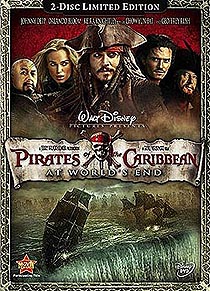 Gore Verbinski (Director - 'Pirates 3')
Gore Verbinski (Director - 'Pirates 3')
'Buried Treasures: Revealed!'
A filmmaker with remarkable visual flair, punk rocker-turned-director Gore Verbinski has crafted a solid career in Hollywood. Easily jumping genres and offering something new in the realm of visual creativity with each film, Verbinski has always seemed up for a challenge.
His movies sometimes haven't been as successful as his ambitions, but his willingness to reach for new heights ensured that they were, at the very least, wild and involving rides.
With the release of the phenomenally successful 'Pirates of the Caribbean: The Curse of the Black Pearl' in 2004, Verbinski finally hit his celluloid stride. Though many had their doubts that a successful feature could be crafted from little more than a theme-park ride, 'Pirates' proved that, with the right cast and loads of action, anything was possible.
A rollicking adventure for the whole family, the film not only benefited from Verbinski's sharp eye for detail, but also from unforgettable performances by Johnny Depp and Geoffrey Rush. It was also the first film ever to premiere at Disneyland and the first official Disney feature to exceed a PG rating, and Verbinski soon agreed to make a pair of sequels to be produced simultaneously.
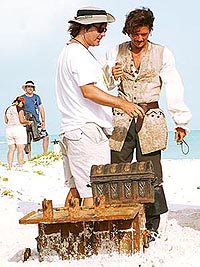
When the first 'Pirates' sequel, subtitled 'Dead Man's Chest,' opened in July of 2006 it set box office records for biggest single day and biggest opening weekend, and became the first film to make 100 million in two days. 'Pirates of the Caribbean - At World's End,' the third of the trilogy did much the same upon its cinematic release and will continue to rack up the worldwide gross upon its US home video release date of December 4th, 2007.
Sitting in on a recent Virtual Roundtable Press Junket with Gore Verbinski for 'Pirates of the Caribbean - At World's End' on DVD, he chatted vibrantly about most all of the Special Features that the home audience were about to see the behind-the-scenes magic finally revealed, upon their purchase of said DVD.
The Maelstrom scene proved to be a major success, but also offered up major effects obstacles. Was there ever a moment you didn't think it was going to work out? Gore Verbinski - "Definitely, the biggest issue hit us about 8 weeks prior to the release. We were suffering from a scaling issue that seemed insurmountable. The physics of a whirpool this size overwhelmed the team at ILM. The path we were heading down was not achieving the desired results so it all had to be reworked."

"The initial rendered backgrounds were used as out of focus plates for close-ups which bought us time by getting 100 or so shots in the pipeline and allowed us to completely rethink and re-render the maelstrom for all of the wide shots. This is the exact opposite of how you would normally go about producing this sequence. John Knoll and the team at ILM ultimately pulled it off, but it was a real nail bighter."
Being that it was such a complicated sequence to pull off, were they any shots that proved too difficult, that you just couldn't quite get right? "Most of the time the initial response from the producers or crew, when viewing the storyboards, was that this sequence was unachievable. But when you have the best in the business working with you, and you are willing to break apart each shot into it's components, the impossible eventually becomes a reality."
You said on the bonus material that all of the sets begin with drawings on a napkin. When you now watch the finished movie, how close did the sets come to what was envisioned during the napkin drawing? "The creative process is complex. I try to be specific and deliberate as I storyboard and pre-visualize the entire film. Yet, I am constantly aware that this process can make a film cold and clinical. I try to remain open to gifts that a little bit of randomness can provide along the way. The contributions of others is essential in creating that particular form of 'controlled chaos.' The napkin drawing is a starting point from which I encourage evolution. Most of the time the concept remains intact but execution shifts dramatically."
In general, what are your thoughts on DVD extras? "Some directors bemoan the idea of revealing the mechanics behind the magic and other guys love revealing how it's all done. What are your thoughts on the issue? These films are a different species completely. The process of making them has been such a wondrous and strange adventure, I think it serves as a form of entertainment itself. Nobody wants to show their dirty laundry, but ownership of these movies belongs as much to the audience as it does the filmmakers."
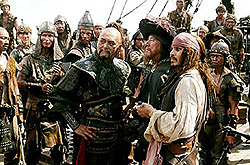
Was the making of POTC 3 as hectic as was portrayed in the DVD of POTC 2? "'At World's End' had to be in theatres 10 months after the release of Dead Man's Chest. Hectic? How about insane? Fortunately the cast and crew found their stride enabling us to work intuitively throughout the madness."
Of all of the special features on the POTC: At World's End DVD, is there one featurette or one segment that stands out to you as being your favorite or the most interesting? "Yes, the making of the Maelstrom gives you a small window into the complexity of creating and executing a sequence that has never been accomplished before. Months in planning and 8 weeks of shooting required a synergy between stunts, camera, practical effects and visual effects. Day after day we were operating amid 100 miles per hour winds, cascading rain and debris, deafening cannon fire with 150 sword wielding stuntmen battling across two undulating vessels on the largest gimbals ever constructed for filming."
"Although artificially created, practically speaking, we were filming a battle within a massive storm. I think the viewer will get a good sense of what everyone went through to bring this to the big screen."
You visited a lot of exotic locations during your time working on the trilogy. Which was your favorite and did you ever get a moments peace to enjoy any of them? "St Vincent and the Exumas were fantastic, but I really recommend Dominica for those who want to go back in time. We stayed and rented homes and bought fish from the locals and barbequed on the beach every night after wrap. There was very little time off but the community of the island melded with production in a way that I have never witnessed. That was a special place."

Where there times that you had to hold back Johnny Depp a little, or did you just let him do his Jack Sparrow thing? "Johnny and I love pushing Jack as far as he can go, but we are also aware that keeping him unpredictable rerquires an constant oscilation between the dramatic and the absurd. So, it's both spurs and reigns - constantly."
What's the significance of Jack's peanut? "Exactly!"
Ooookaaaaay! So, how hard is it to keep the story in mind if your so busy with a lot of technology and computer generated images? "Visual effects are a tool in the filmmakers toolbox. Once you become acquainted with them they cease to be distracting. I always try to keep story foremost in my mind while shooting."
How much planning goes into “The Making of...” extras and how deeply are you involved? "It is really an issue of documenting the madness. There must be a million hours of digital video that the 'making of folks' are combing through. (Someone was on set videotaping every day.) They show me the cut footage and most of the time I just have this sort of Vietnam flashback moment and then say, 'sure why not?' I do believe the process of this production is just about as mad and bold an adventure as the narrative itself."
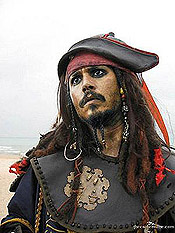
What is the movie scene that gave you much satisfaction once shooted? "The scene with Jack and the crabs. I have always been fascinated by the work of Miyazaki. When we needed to get the Black Pearl back to the ocean, I thought, why are we limited to the rules of live action film making? Once those shackles are off, it is quite liberating. All sorts of ideas start to germinate. The crab is Tia Dalma's “motif.” Why not do something surreal and connected to her? Giving his escape a subtextual intention."
How was it working as a guitarist on the score? "That was a blast. But my contribution is a pimple on the ass of a tick crawling along the ankle of a behemoth endeavor. Hans Zimmer and his entire team did all the work."
What worries you more as a director in general: big scale scenes or intimate ones? "It is always the intimate ones that require the most attention to detail."
Do you have any visual dreams that are technically still impossible to do but can be done in the near future? "I think Hollywood invention has always been somewhat limitless. You may have relied on a bit of claymation, filmed lizards for dinosaurs, or depicted Chuck Heston parting the seas but what continues to change is execution: design aesthetic and photo realism continue to evolve. For me the limits have always resided with our imagination. The struggle is to conceive something unique. If you can achieve this, then the underlying concept or idea even badly executed, will always outshine the polished cliche."
You've been featured on Premier's most powerful list. Do you feel powerful these days? "Only when I wear my eyepatch."
Are you planning on doing a 4th part? "I think the trilogy is now complete. All of the stories set in motion by the first film have been resolved. If there ever were another Pirates of the Caribbean film, I would start fresh and focus on the further adventures of Captain Jack Sparrow."
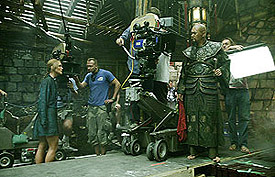
The beginning of POTC3 is awfully grim, were there any creative struggles with Disney to open the film that way? "It is interesting to me that Disney as a brand is somehow equated with 'happy meals and soccer moms.' Yet Walt Disney was well aware of the necessity of drama within a narrative. He made "Bambi" and " Old Yeller" both of which had their grim moments that were essential in creating the emotional stakes of those pictures. I think we have remained true to the brand and the folks running the studio today were kind enough to let me stand by these principles."
Was there ever going to be a death scene for The Kraken or was it a conscious decision to treat his fate as shown here? "For me the Kraken was played out in Dead Man's Chest. I think the idea that Beckett had Jones "put him down" is far more haunting then witnessing the process. Beckett is the killer of myths. It is the end of an era and both Jack and Barbossa recognize their own imminent extinction in this changing world, while they gaze upon the carcass of the leviathan."
Could you talk about the development of this trilogy? Was it always in the back of your mind to have multiple films, or did the idea of the trilogy come about after the success of the first film? In which case, what were the challenges that the screenwriters faced, and what "guidelines" were they given? "The first film was originally designed as a "one off." We were so under the radar because honestly I don't think anyone thought we could resurrect the genre. After the success of "Curse of the Black Pearl" we set about reverse engineering a trilogy. Some loose ends from the first film became assets in the process: Bootstrap Bill for instance, the 'P' brand on Jack's arm, the mention of the East India Trading Company etc. other ideas like the Kraken and Davy Jones were discussed during the development of POTC1 but abandoned as that film took shape, and resurrected for the subsequent films once we knew were making them."
"Yet whenever you set out to make a film, I think you have the obligation to create characters that feel as if they come from other stories -- even Pintel and Ragetti have their own origins and destinations. Ted Elliott and Terry Rossio are well versed in mythology and I enjoyed collaborating with them all the way up until each scene was photographed."
What's the coolest souvenir that you've kept from the series? "Jack's peanut!"
Was Terry Gilliam an influence on the Purgatory sequence? "I love Terry's work but I think Miyazaki and Salvador Dali were probably more influential for that particular scene."How much freedom did you have to take in improv ideas on the day considering the complexity of the production and the integration with the FX? "I try to plan everything to the utmost detail. Yet, I am not talented enough to ignore those random gifts that occur throughout the process. I strive to create an environment that encourages the accumulation of unique and original ideas up till the last possible moment."
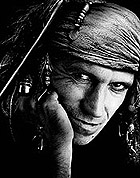
What a hoot it was to see Keith Richards in pirate garb. Who's idea was it to bring him onboard? Mick Jagger has to be jealous?! "That was all Johnny. He and Keith are great friends and I was lucky enough to get the chance to meet and work with the legend. Keith is a unique species in every possible way. But as far as making him into a pirate, we didn't need to do much. Keith makes the rest of us look like we are pretending."
What was he like on set? Was he well behaved?! "Well behaved? Let's just say everything you have heard is true."
Davy Jones' fate, considering his history with Tia is awfullly sad, was it hard to flesh out his back story, and still make him an obvious bad guy? "Davy was the villain in Dead Man's Chest and more the victim in At World's End. It was always our intention to create a parallel between Jones/Tia Dalma relationship and the Will/Elizabeth love story. However Will and Elizabeth choose to suffer the pain of love, while Jones cut out his own heart to avoid it."
"As a villain, Jones was born out of tragedy. For him it is all personal, he wants you to suffer as he has. Beckett on the other hand is far more clinical. To me he is much scarier because it isn't personal at all. He represents the future, the faceless corporation at the expense of the individual. The fate of Jones is as much the result of his misguided anger towards Tia Dalma as it is the consequence of progress."
What is it about pirates, which by their own admission are some of the world's most horrible and scuzzy people, that makes them so appealing to so many? "Rebellion, same as Sid Vicious!"
What effect, if any, does it have on a director when he knows his film is going to be shown in HD? Do you approach anything in the production process differently, as a result? "No. Everything is orchestrated towards the theatrical release and must survive that resolution. HD is still below the resolution of the original camera negative and therefore cannot reveal any flaws that were not scene by the release print. The only challenge is retaining the same look as the film while operating in a different color space."

With the "up is down" riddle and the ship flipping over to enable the gang to get back to the world as they know it, you picked up on a bit that was in the very first film. And THAT seemed an homage to "The Crimson Pirate." Were there any other intentional homages to previous pirate films or pirate actors? "There is a wonderful moment in "The Black Pirate" where Douglas Fairbanks Sr. cuts the sail and is blown up to the yardarm. They achieved this by reverse printing the shot. During the maelstrom sequence we have a similar moment when Jack Sparrow attempts to escape from Jones. Yet with today's technology, I feel we were able to achieve a far greater sense of scale. Pirate films are full of moments that we tip our hat to from time to time in celebrating the genre. "The Crimson Pirate", "Captain Blood" and "The Black Pirate" are a few of my favorites."
You used multiple actors dressed like Captain Jack and used models and soundstages to create the phenomenal effects of this film, rather than relying solely on CG the way some directors might have. Could you talk about your commitment to the "old" ways of creating special effects, and why you might still embrace them? "I am not trying to reinvent the wheel. When we set out to do something with visual effects it is often the combination of the old and the new. When a technique or physical effect is working I will always prefer to shoot it live. This process allows for the greatest sense of realism and keeps the viewer guessing what is "in camera" and what is CGI."
What sort of difficulties did you have in sustaining the level of energy for so long in the final battlle scene in the whilrpool? "By this time in production of P2 and P3 we had been shooting for close to 200 days. I think everyone was exhausted, but when the wind and the rain come on you wake up quickly."
You mentioned earlier how it surprised people that you were able to revive the genre. Could you talk about what conventions you kept and what you added that might have been responsible for the revival? "I think splicing the pirate genre and the ghost story together was the key. But most certainly Johnny Depp's performance of Captain Jack Sparrow was the exponential factor."
Finally, on one of the bonus features you say that this is the biggest film anybody on your crew will ever work on, that it's the end of an era. Could you talk about the "big films" that may have had such an impact on you that their effects may have made it into your own "Pirates" trilogy? "What I meant to imply is that the process of filming is changing. More and more we are relying on the computer to create the worlds we see on the screen. The crew of all three films is the best I have ever worked with and we are all tipping our hat to a process that is fading away. I'm a fan of the small film really, of the process of traveling to locations, getting dirt under your fingernails and working with people within the elements. Pirates 3 was big, but it was also an incredible amalgamation of low tech and high tech. The physical part of this process is sadly diminishing. Ironically this is the exact thematic that "At World's End" deals with: It is the end of an era!"
'Pirates of the Caribbean - At World's End' Special Edition DVD Purchase Link
Back To Archives

